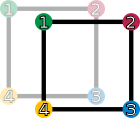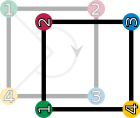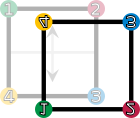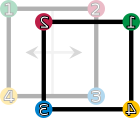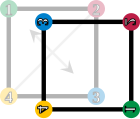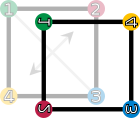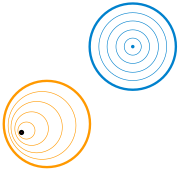From Wikipedia, the free encyclopedia
In mathematics, a group is an algebraic structure consisting of a set of elements together with an operation that combines any two elements to form a third element. The operation satisfies four conditions called the group axioms, namely closure, associativity, identity and invertibility. One of the most familiar examples of a group is the set of integers together with the addition operation; the addition of any two integers forms another integer. The abstract formalization of the group axioms, detached as it is from the concrete nature of any particular group and its operation, allows entities with highly diverse mathematical origins in abstract algebra and beyond to be handled in a flexible way, while retaining their essential structural aspects. The ubiquity of groups in numerous areas within and outside mathematics makes them a central organizing principle of contemporary mathematics.[1][2]
Groups share a fundamental kinship with the notion of symmetry. For example, a symmetry group encodes symmetry features of a geometrical object: the group consists of the set of transformations that leave the object unchanged and the operation of combining two such transformations by performing one after the other. Lie groups are the symmetry groups used in the Standard Model of particle physics; Point groups are used to help understand symmetry phenomena in molecular chemistry; and Poincaré groups can express the physical symmetry underlying special relativity.
The concept of a group arose from the study of polynomial equations, starting with Évariste Galois in the 1830s. After contributions from other fields such as number theory and geometry, the group notion was generalized and firmly established around 1870. Modern group theory—an active mathematical discipline—studies groups in their own right.a[›] To explore groups, mathematicians have devised various notions to break groups into smaller, better-understandable pieces, such as subgroups, quotient groups and simple groups. In addition to their abstract properties, group theorists also study the different ways in which a group can be expressed concretely (its group representations), both from a theoretical and a computational point of view. A theory has been developed for finite groups, which culminated with the classification of finite simple groups announced in 1983.aa[›] Since the mid-1980s, geometric group theory, which studies finitely generated groups as geometric objects, has become a particularly active area in group theory.
Definition and illustration
First example: the integers
One of the most familiar groups is the set of integers Z which consists of the numbersThe following properties of integer addition serve as a model for the abstract group axioms given in the definition below.
- For any two integers a and b, the sum a + b is also an integer. Thus, adding two integers never yields some other type of number, such as a fraction. This property is known as closure under addition.
- For all integers a, b and c, (a + b) + c = a + (b + c). Expressed in words, adding a to b first, and then adding the result to c gives the same final result as adding a to the sum of b and c, a property known as associativity.
- If a is any integer, then 0 + a = a + 0 = a. Zero is called the identity element of addition because adding it to any integer returns the same integer.
- For every integer a, there is an integer b such that a + b = b + a = 0. The integer b is called the inverse element of the integer a and is denoted −a.
Definition
A group is a set, G, together with an operation • (called the group law of G) that combines any two elements a and b to form another element, denoted a • b or ab. To qualify as a group, the set and operation, (G, •), must satisfy four requirements known as the group axioms:[5]- Closure
- For all a, b in G, the result of the operation, a • b, is also in G.b[›]
- Associativity
- For all a, b and c in G, (a • b) • c = a • (b • c).
- Identity element
- There exists an element e in G, such that for every element a in G, the equation e • a = a • e = a holds. Such an element is unique (see below), and thus one speaks of the identity element.
- Inverse element
- For each a in G, there exists an element b in G such that a • b = b • a = e, where e is the identity element.
- a • b = b • a
The identity element of a group G is often written as 1 or 1G,[6] a notation inherited from the multiplicative identity.
The identity element may also be written as 0, especially if the group operation is denoted by +, in which case the group is called an additive group. The identity element can also be written as id.
The set G is called the underlying set of the group (G, •). Often the group's underlying set G is used as a short name for the group (G, •). Along the same lines, shorthand expressions such as "a subset of the group G" or "an element of group G" are used when what is actually meant is "a subset of the underlying set G of the group (G, •)" or "an element of the underlying set G of the group (G, •)". Usually, it is clear from the context whether a symbol like G refers to a group or to an underlying set.
Second example: a symmetry group
Two figures in the plane are congruent if one can be changed into the other using a combination of rotations, reflections, and translations. Any figure is congruent to itself. However, some figures are congruent to themselves in more than one way, and these extra congruences are called symmetries. A square has eight symmetries. These are:- the identity operation leaving everything unchanged, denoted id;
- rotations of the square around its center by 90° right, 180° right, and 270° right, denoted by r1, r2 and r3, respectively;
- reflections about the vertical and horizontal middle line (fh and fv), or through the two diagonals (fd and fc).
- b • a ("apply the symmetry b after performing the symmetry a").
The group table on the right lists the results of all such compositions possible. For example, rotating by 270° right (r3) and then reflecting horizontally (fh) is the same as performing a reflection along the diagonal (fd). Using the above symbols, highlighted in blue in the group table:
- fh • r3 = fd.
| • | id | r1 | r2 | r3 | fv | fh | fd | fc |
|---|---|---|---|---|---|---|---|---|
| id | id | r1 | r2 | r3 | fv | fh | fd | fc |
| r1 | r1 | r2 | r3 | id | fc | fd | fv | fh |
| r2 | r2 | r3 | id | r1 | fh | fv | fc | fd |
| r3 | r3 | id | r1 | r2 | fd | fc | fh | fv |
| fv | fv | fd | fh | fc | id | r2 | r1 | r3 |
| fh | fh | fc | fv | fd | r2 | id | r3 | r1 |
| fd | fd | fh | fc | fv | r3 | r1 | id | r2 |
| fc | fc | fv | fd | fh | r1 | r3 | r2 | id |
| The elements id, r1, r2, and r3 form a subgroup, highlighted in red (upper left region). A left and right coset of this subgroup is highlighted in green (in the last row) and yellow (last column), respectively. | ||||||||
Given this set of symmetries and the described operation, the group axioms can be understood as follows:
- The closure axiom demands that the composition b • a of any two symmetries a and b is also a symmetry. Another example for the group operation is
- r3 • fh = fc,
- The associativity constraint deals with composing more than two symmetries: Starting with three elements a, b and c of D4, there are two possible ways of using these three symmetries in this order to determine a symmetry of the square. One of these ways is to first compose a and b into a single symmetry, then to compose that symmetry with c. The other way is to first compose b and c, then to compose the resulting symmetry with a. The associativity condition
- (a • b) • c = a • (b • c)
While associativity is true for the symmetries of the square and addition of numbers, it is not true for all operations. For instance, subtraction of numbers is not associative: (7 − 3) − 2 = 2 is not the same as 7 − (3 − 2) = 6.(fd • fv) • r2 = r3 • r2 = r1, which equals fd • (fv • r2) = fd • fh = r1. - The identity element is the symmetry id leaving everything unchanged: for any symmetry a, performing id after a (or a after id) equals a, in symbolic form,
- id • a = a,
- a • id = a.
- An inverse element undoes the transformation of some other element. Every symmetry can be undone: each of the following transformations—identity id, the reflections fh, fv, fd, fc and the 180° rotation r2—is its own inverse, because performing it twice brings the square back to its original orientation. The rotations r3 and r1 are each other's inverses, because rotating 90° and then rotation 270° (or vice versa) yields a rotation over 360° which leaves the square unchanged. In symbols,
- fh • fh = id,
- r3 • r1 = r1 • r3 = id.
History
The modern concept of an abstract group developed out of several fields of mathematics.[8][9][10] The original motivation for group theory was the quest for solutions of polynomial equations of degree higher than 4. The 19th-century French mathematician Évariste Galois, extending prior work of Paolo Ruffini and Joseph-Louis Lagrange, gave a criterion for the solvability of a particular polynomial equation in terms of the symmetry group of its roots (solutions). The elements of such a Galois group correspond to certain permutations of the roots. At first, Galois' ideas were rejected by his contemporaries, and published only posthumously.[11][12] More general permutation groups were investigated in particular by Augustin Louis Cauchy. Arthur Cayley's On the theory of groups, as depending on the symbolic equation θn = 1 (1854) gives the first abstract definition of a finite group.[13]Geometry was a second field in which groups were used systematically, especially symmetry groups as part of Felix Klein's 1872 Erlangen program.[14] After novel geometries such as hyperbolic and projective geometry had emerged, Klein used group theory to organize them in a more coherent way. Further advancing these ideas, Sophus Lie founded the study of Lie groups in 1884.[15]
The third field contributing to group theory was number theory. Certain abelian group structures had been used implicitly in Carl Friedrich Gauss' number-theoretical work Disquisitiones Arithmeticae (1798), and more explicitly by Leopold Kronecker.[16] In 1847, Ernst Kummer made early attempts to prove Fermat's Last Theorem by developing groups describing factorization into prime numbers.[17]
The convergence of these various sources into a uniform theory of groups started with Camille Jordan's Traité des substitutions et des équations algébriques (1870).[18] Walther von Dyck (1882) gave the first statement of the modern definition of an abstract group.[19] As of the 20th century, groups gained wide recognition by the pioneering work of Ferdinand Georg Frobenius and William Burnside, who worked on representation theory of finite groups, Richard Brauer's modular representation theory and Issai Schur's papers.[20] The theory of Lie groups, and more generally locally compact groups was studied by Hermann Weyl, Élie Cartan and many others.[21] Its algebraic counterpart, the theory of algebraic groups, was first shaped by Claude Chevalley (from the late 1930s) and later by the work of Armand Borel and Jacques Tits.[22]
The University of Chicago's 1960–61 Group Theory Year brought together group theorists such as Daniel Gorenstein, John G. Thompson and Walter Feit, laying the foundation of a collaboration that, with input from numerous other mathematicians, classified all finite simple groups in 1982. This project exceeded previous mathematical endeavours by its sheer size, in both length of proof and number of researchers. Research is ongoing to simplify the proof of this classification.[23] These days, group theory is still a highly active mathematical branch, impacting many other fields.a[›]
Elementary consequences of the group axioms
Basic facts about all groups that can be obtained directly from the group axioms are commonly subsumed under elementary group theory.[24] For example, repeated applications of the associativity axiom show that the unambiguity of- a • b • c = (a • b) • c = a • (b • c)
The axioms may be weakened to assert only the existence of a left identity and left inverses. Both can be shown to be actually two-sided, so the resulting definition is equivalent to the one given above.[26]
Uniqueness of identity element and inverses
Two important consequences of the group axioms are the uniqueness of the identity element and the uniqueness of inverse elements. There can be only one identity element in a group, and each element in a group has exactly one inverse element. Thus, it is customary to speak of the identity, and the inverse of an element.[27]To prove the uniqueness of an inverse element of a, suppose that a has two inverses, denoted b and c, in a group (G, •). Then
b = b • e as e is the identity element = b • (a • c) because c is an inverse of a, so e = a • c = (b • a) • c by associativity, which allows to rearrange the parentheses = e • c since b is an inverse of a, i.e. b • a = e = c for e is the identity element
Division
In groups, it is possible to perform division: given elements a and b of the group G, there is exactly one solution x in G to the equation x • a = b.[27] In fact, right multiplication of the equation by a−1 gives the solution x = x • a • a−1 = b • a−1. Similarly there is exactly one solution y in G to the equation a • y = b, namely y = a−1 • b. In general, x and y need not agree.A consequence of this is that multiplying by a group element g is a bijection. Specifically, if g is an element of the group G, there is a bijection from G to itself called left translation by g sending h ∈ G to g • h. Similarly, right translation by g is a bijection from G to itself sending h to h • g. If G is abelian, left and right translation by a group element are the same.
Basic concepts
- The following sections use mathematical symbols such as X = {x, y, z} to denote a set X containing elements x, y, and z, or alternatively x ∈ X to restate that x is an element of X. The notation f : X → Y means f is a function assigning to every element of X an element of Y.
Group homomorphisms
Group homomorphismsg[›] are functions that preserve group structure. A function a: G → H between two groups (G, •) and (H, ∗) is called a homomorphism if the equation- a(g • k) = a(g) ∗ a(k)
Two groups G and H are called isomorphic if there exist group homomorphisms a: G → H and b: H → G, such that applying the two functions one after another in each of the two possible orders gives the identity functions of G and H. That is, a(b(h)) = h and b(a(g)) = g for any g in G and h in H. From an abstract point of view, isomorphic groups carry the same information. For example, proving that g • g = 1G for some element g of G is equivalent to proving that a(g) ∗ a(g) = 1H, because applying a to the first equality yields the second, and applying b to the second gives back the first.
Subgroups
Informally, a subgroup is a group H contained within a bigger one, G.[30] Concretely, the identity element of G is contained in H, and whenever h1 and h2 are in H, then so are h1 • h2 and h1−1, so the elements of H, equipped with the group operation on G restricted to H, indeed form a group.In the example above, the identity and the rotations constitute a subgroup R = {id, r1, r2, r3}, highlighted in red in the group table above: any two rotations composed are still a rotation, and a rotation can be undone by (i.e. is inverse to) the complementary rotations 270° for 90°, 180° for 180°, and 90° for 270° (note that rotation in the opposite direction is not defined). The subgroup test is a necessary and sufficient condition for a subset H of a group G to be a subgroup: it is sufficient to check that g−1h ∈ H for all elements g, h ∈ H. Knowing the subgroups is important in understanding the group as a whole.d[›]
Given any subset S of a group G, the subgroup generated by S consists of products of elements of S and their inverses. It is the smallest subgroup of G containing S.[31] In the introductory example above, the subgroup generated by r2 and fv consists of these two elements, the identity element id and fh = fv • r2. Again, this is a subgroup, because combining any two of these four elements or their inverses (which are, in this particular case, these same elements) yields an element of this subgroup.
Cosets
In many situations it is desirable to consider two group elements the same if they differ by an element of a given subgroup. For example, in D4 above, once a reflection is performed, the square never gets back to the r2 configuration by just applying the rotation operations (and no further reflections), i.e. the rotation operations are irrelevant to the question whether a reflection has been performed. Cosets are used to formalize this insight: a subgroup H defines left and right cosets, which can be thought of as translations of H by arbitrary group elements g. In symbolic terms, the left and right cosets of H containing g are- gH = {g • h : h ∈ H} and Hg = {h • g : h ∈ H}, respectively.[32]
In D4, the introductory symmetry group, the left cosets gR of the subgroup R consisting of the rotations are either equal to R, if g is an element of R itself, or otherwise equal to U = fcR = {fc, fv, fd, fh} (highlighted in green). The subgroup R is also normal, because fcR = U = Rfc and similarly for any element other than fc. (In fact, in the case of D4, observe that all such cosets are equal, such that fhR = fvR = fdR = fcR.)
Quotient groups
In some situations the set of cosets of a subgroup can be endowed with a group law, giving a quotient group or factor group. For this to be possible, the subgroup has to be normal. Given any normal subgroup N, the quotient group is defined by- G / N = {gN, g ∈ G}, "G modulo N".[34]
| • | R | U |
|---|---|---|
| R | R | U |
| U | U | R |
| Group table of the quotient group D4 / R. | ||
The elements of the quotient group D4 / R are R itself, which represents the identity, and U = fvR. The group operation on the quotient is shown at the right. For example, U • U = fvR • fvR = (fv • fv)R = R. Both the subgroup R = {id, r1, r2, r3}, as well as the corresponding quotient are abelian, whereas D4 is not abelian. Building bigger groups by smaller ones, such as D4 from its subgroup R and the quotient D4 / R is abstracted by a notion called semidirect product.
Quotient groups and subgroups together form a way of describing every group by its presentation: any group is the quotient of the free group over the generators of the group, quotiented by the subgroup of relations. The dihedral group D4, for example, can be generated by two elements r and f (for example, r = r1, the right rotation and f = fv the vertical (or any other) reflection), which means that every symmetry of the square is a finite composition of these two symmetries or their inverses. Together with the relations
- r 4 = f 2 = (r • f)2 = 1,[35]
Sub- and quotient groups are related in the following way: a subset H of G can be seen as an injective map H → G, i.e. any element of the target has at most one element that maps to it. The counterpart to injective maps are surjective maps (every element of the target is mapped onto), such as the canonical map G → G / N.y[›] Interpreting subgroup and quotients in light of these homomorphisms emphasizes the structural concept inherent to these definitions alluded to in the introduction. In general, homomorphisms are neither injective nor surjective. Kernel and image of group homomorphisms and the first isomorphism theorem address this phenomenon.
Examples and applications

A periodic wallpaper pattern gives rise to a wallpaper group.
The fundamental group of a plane minus a point (bold) consists of loops around the missing point. This group is isomorphic to the integers.
Examples and applications of groups abound. A starting point is the group Z of integers with addition as group operation, introduced above. If instead of addition multiplication is considered, one obtains multiplicative groups. These groups are predecessors of important constructions in abstract algebra.
Groups are also applied in many other mathematical areas. Mathematical objects are often examined by associating groups to them and studying the properties of the corresponding groups. For example, Henri Poincaré founded what is now called algebraic topology by introducing the fundamental group.[36] By means of this connection, topological properties such as proximity and continuity translate into properties of groups.i[›] For example, elements of the fundamental group are represented by loops. The second image at the right shows some loops in a plane minus a point. The blue loop is considered null-homotopic (and thus irrelevant), because it can be continuously shrunk to a point. The presence of the hole prevents the orange loop from being shrunk to a point. The fundamental group of the plane with a point deleted turns out to be infinite cyclic, generated by the orange loop (or any other loop winding once around the hole). This way, the fundamental group detects the hole.
In more recent applications, the influence has also been reversed to motivate geometric constructions by a group-theoretical background.j[›] In a similar vein, geometric group theory employs geometric concepts, for example in the study of hyperbolic groups.[37] Further branches crucially applying groups include algebraic geometry and number theory.[38]
In addition to the above theoretical applications, many practical applications of groups exist. Cryptography relies on the combination of the abstract group theory approach together with algorithmical knowledge obtained in computational group theory, in particular when implemented for finite groups.[39] Applications of group theory are not restricted to mathematics; sciences such as physics, chemistry and computer science benefit from the concept.
Numbers
Many number systems, such as the integers and the rationals enjoy a naturally given group structure. In some cases, such as with the rationals, both addition and multiplication operations give rise to group structures. Such number systems are predecessors to more general algebraic structures known as rings and fields. Further abstract algebraic concepts such as modules, vector spaces and algebras also form groups.Integers
The group of integers Z under addition, denoted (Z, +), has been described above. The integers, with the operation of multiplication instead of addition, (Z, ·) do not form a group. The closure, associativity and identity axioms are satisfied, but inverses do not exist: for example, a = 2 is an integer, but the only solution to the equation a · b = 1 in this case is b = 1/2, which is a rational number, but not an integer. Hence not every element of Z has a (multiplicative) inverse.k[›]Rationals
The desire for the existence of multiplicative inverses suggests considering fractionsHowever, the set of all nonzero rational numbers Q ∖ {0} = {q ∈ Q | q ≠ 0} does form an abelian group under multiplication, denoted (Q ∖ {0}, ·).m[›] Associativity and identity element axioms follow from the properties of integers. The closure requirement still holds true after removing zero, because the product of two nonzero rationals is never zero. Finally, the inverse of a/b is b/a, therefore the axiom of the inverse element is satisfied.
The rational numbers (including 0) also form a group under addition. Intertwining addition and multiplication operations yields more complicated structures called rings and—if division is possible, such as in Q—fields, which occupy a central position in abstract algebra. Group theoretic arguments therefore underlie parts of the theory of those entities.n[›]
Modular arithmetic
In modular arithmetic, two integers are added and then the sum is divided by a positive integer called the modulus. The result of modular addition is the remainder of that division. For any modulus, n, the set of integers from 0 to n − 1 forms a group under modular addition: the inverse of any element a is n − a, and 0 is the identity element. This is familiar from the addition of hours on the face of a clock: if the hour hand is on 9 and is advanced 4 hours, it ends up on 1, as shown at the right. This is expressed by saying that 9 + 4 equals 1 "modulo 12" or, in symbols,
- 9 + 4 ≡ 1 modulo 12.
For any prime number p, there is also the multiplicative group of integers modulo p.[40] Its elements are the integers 1 to p − 1. The group operation is multiplication modulo p. That is, the usual product is divided by p and the remainder of this division is the result of modular multiplication. For example, if p = 5, there are four group elements 1, 2, 3, 4. In this group, 4 · 4 = 1, because the usual product 16 is equivalent to 1, which divided by 5 yields a remainder of 1. for 5 divides 16 − 1 = 15, denoted
- 16 ≡ 1 (mod 5).
- a · b ≡ 1 (mod p), i.e. p divides the difference a · b − 1.
Cyclic groups

A cyclic group is a group all of whose elements are powers of a particular element a.[43] In multiplicative notation, the elements of the group are:
- ..., a−3, a−2, a−1, a0 = e, a, a2, a3, ...,
- ..., −a−a, −a, 0, a, a+a, ...
Some cyclic groups have an infinite number of elements. In these groups, for every non-zero element a, all the powers of a are distinct; despite the name "cyclic group", the powers of the elements do not cycle. An infinite cyclic group is isomorphic to (Z, +), the group of integers under addition introduced above.[45] As these two prototypes are both abelian, so is any cyclic group.
The study of finitely generated abelian groups is quite mature, including the fundamental theorem of finitely generated abelian groups; and reflecting this state of affairs, many group-related notions, such as center and commutator, describe the extent to which a given group is not abelian.[46]
Symmetry groups
Symmetry groups are groups consisting of symmetries of given mathematical objects—be they of geometric nature, such as the introductory symmetry group of the square, or of algebraic nature, such as polynomial equations and their solutions.[47] Conceptually, group theory can be thought of as the study of symmetry.t[›] Symmetries in mathematics greatly simplify the study of geometrical or analytical objects. A group is said to act on another mathematical object X if every group element performs some operation on X compatibly to the group law. In the rightmost example below, an element of order 7 of the (2,3,7) triangle group acts on the tiling by permuting the highlighted warped triangles (and the other ones, too). By a group action, the group pattern is connected to the structure of the object being acted on.In chemical fields, such as crystallography, space groups and point groups describe molecular symmetries and crystal symmetries. These symmetries underlie the chemical and physical behavior of these systems, and group theory enables simplification of quantum mechanical analysis of these properties.[48] For example, group theory is used to show that optical transitions between certain quantum levels cannot occur simply because of the symmetry of the states involved.
Not only are groups useful to assess the implications of symmetries in molecules, but surprisingly they also predict that molecules sometimes can change symmetry. The Jahn-Teller effect is a distortion of a molecule of high symmetry when it adopts a particular ground state of lower symmetry from a set of possible ground states that are related to each other by the symmetry operations of the molecule.[49][50]
Likewise, group theory helps predict the changes in physical properties that occur when a material undergoes a phase transition, for example, from a cubic to a tetrahedral crystalline form. An example is ferroelectric materials, where the change from a paraelectric to a ferroelectric state occurs at the Curie temperature and is related to a change from the high-symmetry paraelectric state to the lower symmetry ferroelectic state, accompanied by a so-called soft phonon mode, a vibrational lattice mode that goes to zero frequency at the transition.[51]
Such spontaneous symmetry breaking has found further application in elementary particle physics, where its occurrence is related to the appearance of Goldstone bosons.
 |
 |
 |
 |
 |
| Buckminsterfullerene displays icosahedral symmetry, though the double bonds reduce this to pyritohedral symmetry. |
Ammonia, NH3. Its symmetry group is of order 6, generated by a 120° rotation and a reflection. | Cubane C8H8 features octahedral symmetry. |
Hexaaquacopper(II) complex ion, [Cu(OH2)6]2+. Compared to a perfectly symmetrical shape, the molecule is vertically dilated by about 22% (Jahn-Teller effect). | The (2,3,7) triangle group, a hyperbolic group, acts on this tiling of the hyperbolic plane. |
General linear group and representation theory

Two vectors (the left illustration) multiplied by matrices (the middle and right illustrations). The middle illustration represents a clockwise rotation by 90°, while the right-most one stretches the x-coordinate by factor 2.
Matrix groups consist of matrices together with matrix multiplication. The general linear group GL(n, R) consists of all invertible n-by-n matrices with real entries.[54] Its subgroups are referred to as matrix groups or linear groups. The dihedral group example mentioned above can be viewed as a (very small) matrix group. Another important matrix group is the special orthogonal group SO(n). It describes all possible rotations in n dimensions. Via Euler angles, rotation matrices are used in computer graphics.[55]
Representation theory is both an application of the group concept and important for a deeper understanding of groups.[56][57] It studies the group by its group actions on other spaces. A broad class of group representations are linear representations, i.e. the group is acting on a vector space, such as the three-dimensional Euclidean space R3. A representation of G on an n-dimensional real vector space is simply a group homomorphism
- ρ: G → GL(n, R)
Given a group action, this gives further means to study the object being acted on.x[›] On the other hand, it also yields information about the group. Group representations are an organizing principle in the theory of finite groups, Lie groups, algebraic groups and topological groups, especially (locally) compact groups.[56][58]
Galois groups
Galois groups have been developed to help solve polynomial equations by capturing their symmetry features.[59][60] For example, the solutions of the quadratic equation ax2 + bx + c = 0 are given byThe problem can be dealt with by shifting to field theory and considering the splitting field of a polynomial. Modern Galois theory generalizes the above type of Galois groups to field extensions and establishes—via the fundamental theorem of Galois theory—a precise relationship between fields and groups, underlining once again the ubiquity of groups in mathematics.
Finite groups
A group is called finite if it has a finite number of elements. The number of elements is called the order of the group.[63] An important class is the symmetric groups SN, the groups of permutations of N letters. For example, the symmetric group on 3 letters S3 is the group consisting of all possible orderings of the three letters ABC, i.e. contains the elements ABC, ACB, ..., up to CBA, in total 6 (or 3 factorial) elements. This class is fundamental insofar as any finite group can be expressed as a subgroup of a symmetric group SN for a suitable integer N (Cayley's theorem). Parallel to the group of symmetries of the square above, S3 can also be interpreted as the group of symmetries of an equilateral triangle.The order of an element a in a group G is the least positive integer n such that a n = e, where a n represents
More sophisticated counting techniques, for example counting cosets, yield more precise statements about finite groups: Lagrange's Theorem states that for a finite group G the order of any finite subgroup H divides the order of G. The Sylow theorems give a partial converse.
The dihedral group (discussed above) is a finite group of order 8. The order of r1 is 4, as is the order of the subgroup R it generates (see above). The order of the reflection elements fv etc. is 2. Both orders divide 8, as predicted by Lagrange's theorem. The groups Fp× above have order p − 1.
Classification of finite simple groups
Mathematicians often strive for a complete classification (or list) of a mathematical notion. In the context of finite groups, this aim leads to difficult mathematics. According to Lagrange's theorem, finite groups of order p, a prime number, are necessarily cyclic (abelian) groups Zp. Groups of order p2 can also be shown to be abelian, a statement which does not generalize to order p3, as the non-abelian group D4 of order 8 = 23 above shows.[64] Computer algebra systems can be used to list small groups, but there is no classification of all finite groups.q[›] An intermediate step is the classification of finite simple groups.r[›] A nontrivial group is called simple if its only normal subgroups are the trivial group and the group itself.s[›] The Jordan–Hölder theorem exhibits finite simple groups as the building blocks for all finite groups.[65] Listing all finite simple groups was a major achievement in contemporary group theory. 1998 Fields Medal winner Richard Borcherds succeeded to prove the monstrous moonshine conjectures, a surprising and deep relation of the largest finite simple sporadic group—the "monster group"—with certain modular functions, a piece of classical complex analysis, and string theory, a theory supposed to unify the description of many physical phenomena.[66]Groups with additional structure
Many groups are simultaneously groups and examples of other mathematical structures. In the language of category theory, they are group objects in a category, meaning that they are objects (that is, examples of another mathematical structure) which come with transformations (called morphisms) that mimic the group axioms. For example, every group (as defined above) is also a set, so a group is a group object in the category of sets.Topological groups
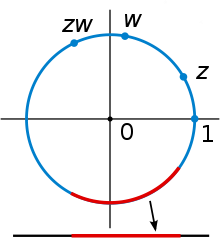
The unit circle in the complex plane under complex multiplication is a Lie group and, therefore, a topological group. It is topological since complex multiplication and division are continuous. It is a manifold and thus a Lie group, because every small piece, such as the red arc in the figure, looks like a part of the real line (shown at the bottom).
Lie groups
Lie groups (in honor of Sophus Lie) are groups which also have a manifold structure, i.e. they are spaces looking locally like some Euclidean space of the appropriate dimension.[71] Again, the additional structure, here the manifold structure, has to be compatible, i.e. the maps corresponding to multiplication and the inverse have to be smooth.A standard example is the general linear group introduced above: it is an open subset of the space of all n-by-n matrices, because it is given by the inequality
- det (A) ≠ 0,
Lie groups are of fundamental importance in modern physics: Noether's theorem links continuous symmetries to conserved quantities.[73] Rotation, as well as translations in space and time are basic symmetries of the laws of mechanics. They can, for instance, be used to construct simple models—imposing, say, axial symmetry on a situation will typically lead to significant simplification in the equations one needs to solve to provide a physical description.v[›] Another example are the Lorentz transformations, which relate measurements of time and velocity of two observers in motion relative to each other. They can be deduced in a purely group-theoretical way, by expressing the transformations as a rotational symmetry of Minkowski space. The latter serves—in the absence of significant gravitation—as a model of space time in special relativity.[74] The full symmetry group of Minkowski space, i.e. including translations, is known as the Poincaré group. By the above, it plays a pivotal role in special relativity and, by implication, for quantum field theories.[75] Symmetries that vary with location are central to the modern description of physical interactions with the help of gauge theory.[76]
Generalizations
In abstract algebra, more general structures are defined by relaxing some of the axioms defining a group.[28][77][78]For example, if the requirement that every element has an inverse is eliminated, the resulting algebraic structure is called a monoid. The natural numbers N (including 0) under addition form a monoid, as do the nonzero integers under multiplication (Z ∖ {0}, ·), see above. There is a general method to formally add inverses to elements to any (abelian) monoid, much the same way as (Q ∖ {0}, ·) is derived from (Z ∖ {0}, ·), known as the Grothendieck group. Groupoids are similar to groups except that the composition a • b need not be defined for all a and b. They arise in the study of more complicated forms of symmetry, often in topological and analytical structures, such as the fundamental groupoid or stacks. Finally, it is possible to generalize any of these concepts by replacing the binary operation with an arbitrary n-ary one (i.e. an operation taking n arguments). With the proper generalization of the group axioms this gives rise to an n-ary group.[79] The table gives a list of several structures generalizing groups.
| Group-like structures. The entries say whether the property is required. | |||||
| Totality* | Associativity | Identity | Divisibility | Commutativity | |
|---|---|---|---|---|---|
| Semicategory | No | Yes | No | No | No |
| Category | No | Yes | Yes | No | No |
| Groupoid | No | Yes | Yes | Yes | No |
| Magma | Yes | No | No | No | No |
| Quasigroup | Yes | No | No | Yes | No |
| Loop | Yes | No | Yes | Yes | No |
| Semigroup | Yes | Yes | No | No | No |
| Monoid | Yes | Yes | Yes | No | No |
| Group | Yes | Yes | Yes | Yes | No |
| Abelian Group | Yes | Yes | Yes | Yes | Yes |
| *Closure, which is used in many sources, is an equivalent axiom to totality, though defined differently. | |||||

